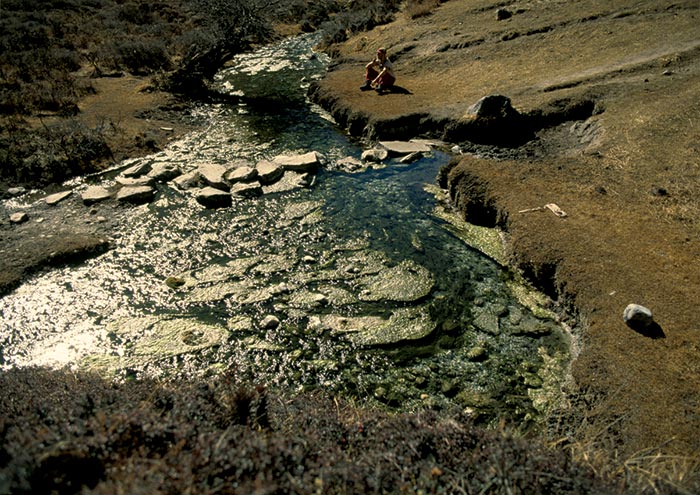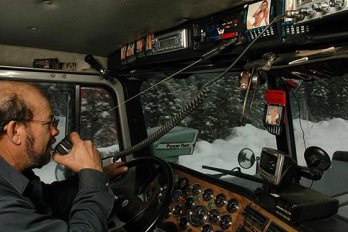In icy depths and on windswept peaks, scientists discover a secret: 55 million years ago the world got hot—very hot. The culprit? Then, as now, a rapid infusion of carbon causing abrupt and extreme climate change. Moving from the laboratory to the field, picking up the dirt, big brains give us straight talk about heat…and cyclones, and conveyor belts, and methane burps on the ocean floor, and the uncontrolled experiment that is planet earth.
It is 24°C at the North Pole. It rains copiously, and the Arctic Ocean feels like a warm bath. The rest of the planet is sweltering. The sea is acidic; ocean currents have stopped or shifted course. As many as half of the single-celled benthic foraminifera, a key part of life on the ocean floor, have been wiped out. Some parts of the world are experiencing extreme flooding, ferocious storms, and frequent cyclones. It is too hot even for tropical jungles, and three-quarters of the Colombian and Venezuelan rainforest has died. It is a global crisis, affecting every part of the land, the air, the ocean, and everything that lives on or in them.
This may sound like something out of a Hollywood disaster movie, but actually these cataclysmic events took place 55 million years ago. During a unique moment in geological history called the Paleocene-Eocene Thermal Maximum (petm), a period lasting roughly 150,000 years between the Paleocene and Eocene eras, the earth got hot—very hot. Nobody is exactly sure what the world was like during the petm or what triggered the warming, but the Hollywood script would benefit from any one of the reigning theories: explosive volcanic activity or a major underwater landslide; changing sea-circulation patterns warming the intermediate ocean waters; or, possibly, a giant asteroid plowing into the earth. Any of these could have unleashed methane hydrates from the ocean floor, which, in turn, would have introduced a massive amount of carbon into the atmosphere, severely disturbing the natural carbon cycle. Fossil remains from the petm are allowing scientists to piece together a picture of that distant world, and there appear to be haunting similarities with our own.
Scientists consider the remains of the petm, which were first discovered fifteen years ago, to be the Rosetta Stone of global climate change, the nearest parallel in the fossil record to what is happening to the planet right now. “It is as close as we can get to an analog,” says Peter Wilf, a geologist at Penn State University. Then as now, tremendous amounts of carbon were rapidly introduced into the atmosphere, and the petm fossil record reveals what lived and what died, where things happened and over what period of time. Scientists can also use it to determine how life on earth responded. This all occurred 10 million years after the extinction of the dinosaurs, when mammals were starting their long rule, but many millions of years before the first human saw light.
As analogues go, it’s an alarming one. It’s not just that the petm carries the stigma of intense global climate change or that the warnings derived from research into the period are eerily consistent with those sounded by former US vice-president Al Gore, British economist Sir Nicholas Stern, and much of the scientific community. The petm also suggests something else: the effects of increased carbon in the atmosphere could be much more dramatic than first expected. In fact, the petm indicates that the catastrophic effects on the planet’s biosphere of a massive rise in carbon levels could come into play in our lifetimes—long before any major steps can be taken to avert the problem. “We are running an uncontrolled experiment,” says Wilf. “I think we’re really, really in for it. The potential for societal breakdown is enormous.”
This is why I am climbing the Pyrenees in northern Spain on a rainy morning. I’ve listened to four days of papers, both esoteric and frightening, on the petm and now I want to put my hands on it, bear witness to what it means. This is the field-trip portion of an extraordinary international conference, Climate and Biota of the Early Paleogene, held every few years for paleontologists and climate scientists studying this piece of history. In June, two of the conference’s superstars, paleoecologists Henk Brinkhuis and Appy Sluijs from the University of Utrecht, scored the cover story in Nature (along with a number of colleagues) based on analysis of sediments from the petm, which were obtained during an Arctic drilling expedition. The samples from the Arctic core demonstrate that the petm was a time of “widespread, extreme climatic warming…associated with massive atmospheric greenhouse gas input.” Sea-surface temperatures near the North Pole, for instance, increased from about 18°C to 23°C. Many of the other papers presented in the auditorium in Bilbao also deal with the disturbing effects of the increase in greenhouse gases during the petm, and many are destined for the same fate as that of Brinkhuis and Sluijs. These studies are a preview of the unsettling science headlines to come.
Carbon is present in the atmosphere in two stable isotopes: heavy and light. When an uncharacteristically large amount of carbon is released, the balance of heavy and light isotopes on the planet changes, and that change is captured in the geological record. Paleontologists investigating the petm see a stunning spike in the light isotope of carbon, an indication that 55 million years ago a tremendous burst of carbon entered the atmosphere—an amount greater than what would have resulted from the incineration of every living thing on land and in the sea.
The scientists can tell that this carbon influx occurred over a period of a few thousand years—a blink of an eye in geological terms—and that it had a dramatic impact on land and sea creatures. According to one of the papers presented in Bilbao, Arctic surface waters actually warmed by 9 or 10°C. The deep sea itself, long thought to be immutable, warmed by 4 or 5°C, and so did the surface temperatures of the cyclone-prone waters of the tropics. Temperatures in the middle of the big continents rose by an average of 5°C. It was a splendid time for mammals, which moved across the continents and mutated into new forms. This period of global adaptation lasted roughly 150,000 years.
Scientists don’t like to ring alarm bells unnecessarily. Nevertheless, in the last decade, the most authoritative reports on climate change have presented increasingly pessimistic worst-case scenarios about rising temperatures. For climate scientists, getting the danger across has been a challenge, to say the least. It’s difficult enough to come to grips with the fact that our actions are altering the planet’s climate system; it’s almost impossible to conceive of rethinking the engine of economic growth—fossil fuels.
Initially, scientists tended to downplay worst-case scenarios. For example, the 1995 report from the Intergovernmental Panel on Climate Change (ipcc), one of three gold-standard reports so far from the United Nations groups that draw together climate findings, postulated a global temperature rise of 3.5°C by 2100 if things got really bad. The level of the ocean, the report concluded, might rise by as much as 95 centimetres—not a great situation to be in, but not the end of civilization as we know it.
The panel’s 2001 report, which informs Al Gore’s lectures, book, and documentary An Inconvenient Truth, went further. Temperatures might increase by as much as 5.8°C, it said. Ocean levels might rise by as much as 88 centimetres, less than originally forecast—unless the Greenland ice sheets were to melt, in which case they could rise by as much as 7 metres. But this was unlikely to happen for thousands of years.
The next report, which is to be released in four parts through 2007, isn’t expected to go much further on the intensity of the shifts. Rather, it will focus on strategies to deal with the coming changes. Privately though, as their predictions about climate change begin to come true, some scientists fear that they have undersold their own findings in two ways: the changes are taking place at the most severe end of the spectrum and they are happening more quickly than many had expected. Global climate change is shaping up to be both intense and abrupt.
In his report on the economics of climate change, which was released in October 2006, Nicholas Stern stated that “prompt and strong action is clearly warranted” and that if no efforts were made to reduce emissions, there was a 50 percent chance that in the longer term the average global temperature could rise by 5°C—a radical increase “equivalent to the change in average temperatures from the last ice age to today.” So just as people are getting used to the idea that the climate is actually changing, that it’s the result of burning fossil fuels, and that the changes will likely alter life on earth as we know it, we are faced with the possibility that it will happen faster than most scientists’ own worst fears. Call it the more inconvenient truth.

We are at the Lizarraga Pass in the wild Pyrenees, part of the Navarre. The fog is heavy, and it feels chilly after the wall of wet heat in Bilbao. Horses are strolling up a mountain path, nosing the grass. Colts play. A clutch of black sheep gaze down at us.
And here is the petm boundary marker, which to me looks like dirt. There are no obvious fossils, no rocks, nothing to distinguish it. Nothing that indicates to me where it begins or ends. But the geologists and paleontologists swarm, wielding hammers and magnifying lenses. They hack away, collecting and carefully labelling samples to take back to their laboratories around the world.
They are seeing stories from the deep past in this dirt. Fifty-five million years ago, this is where land and sea met, explains Robert Speijer, a geologist at Katholieke Universiteit Leuven in Belgium. The movement of tectonic plates forced the Iberian peninsula up against Europe, bringing all of this geological evidence to the surface as the Pyrenees were created. Thanks to that, and to the farmers who likely cleared the forests here during the Middle Ages, this part of the record is now visible and relatively undisturbed.
How, I ask, do they know this is the right spot? “Well, this is the Paleocene,” Speijer says, pointing to the layer of fossil record on the other side of the dirt in question. “And that is certainly Eocene,” he says, pointing to another indistinguishable slice of earth. That means the chunk in the middle is the border between the two epochs, containing stories that could reveal much about the fate of our own world. It is not quite two metres high.
Speijer hands me his hammer and gestures to the seam of dirt where the other geologists are working. I climb over and bang off a piece. It is soft and wet and crumbles a little in my hands. I cradle it in my palms, thinking of the power of the archive I am holding, of the mysteries it may reveal. When I show it to Speijer, he expertly breaks it into pieces, looking for the fossil remains of the ancient foraminifera. The sample crumbles through his fingers and falls to the ground, now just dust.
As far back as 2001, the report from the ipcc warned about abrupt climate change. But because it came amid such a wealth of other information and analysis, it was easy to gloss over the consequences. “Greenhouse gas forcing in the 21st century could set in motion large-scale, high-impact, nonlinear, and potentially abrupt changes in physical and biological systems over the coming decades to millennia, with a wide range of associated likelihoods,” according to the summary for policy-makers. “Some of the projected abrupt/non-linear changes in physical systems and in the natural sources and sinks of greenhouse gases could be irreversible, but there is an incomplete understanding of some of the underlying processes.”
That gap in knowledge provoked further investigations. In the United States, the National Research Council set up a committee on abrupt climate change, which reported in 2002 the “surprising new [finding] that abrupt climate change can occur when gradual causes push the earth system across a threshold.” The authors use the analogy of a finger pressing evenly on a light switch. At some point, even though the pressure stays the same, the tipping point is reached and the switch flips. At that stage, the climate sets off on its own path, at its own pace. The committee concluded that “large, abrupt climate changes have repeatedly affected much or all of the earth, locally reaching as much as 10°C change in 10 years. Available evidence suggests that abrupt climate changes are not only possible but likely in the future, potentially with large impacts on ecosystems and societies.”
By 2003, that scenario had prompted the Pentagon to commission a report on the implications of abrupt climate change for national security. Their findings focused on what would happen if the ocean conveyor belt, which transports heat from the equator to the northern Atlantic Ocean, shut off. It predicted shortages of food, water, and energy that “could potentially de-stabilize the geo-political environment, leading to skirmishes, battles, and even war.…Unlikely alliances could be formed as defense priorities shift and the goal is resources for survival rather than religion, ideology, or national honor.”
It was, in essence, a request for permission to plan for anarchy. Could this really happen? The report’s answer followed: “Ocean, land, and atmosphere scientists at some of the world’s most prestigious organizations have uncovered new evidence over the past decade suggesting that the plausibility of severe and rapid climate change is higher than most of the scientific community and perhaps all of the political community is prepared for. If it occurs, this phenomenon will disrupt current gradual global warming trends, adding to climate complexity and lack of predictability. And paleoclimatic evidence suggests that such an abrupt climate change could begin in the near future.”
The specific piece of the climate picture that spawned these reports was evidence showing that at various points throughout history, the circulation of ocean waters has changed dramatically at the same time as drastic climate fluctuations were underway. How does this relate to what we’re seeing right now? To take one example, as glaciers melt, the salinity of oceans decreases. Less salty water, being lighter, does not sink as easily into the ocean’s depths. This could produce a discernible change in how the conveyor belt transports heat.
Ice-core samples from Greenland show that the conveyor belt shut off 12,700 years ago, during an event called the Younger Dryas, and was operating only weakly 8,300 years ago during a smaller, regional warming. The reigning theory, originally proposed by the oceanographer Wallace Broecker of the Earth Institute at Columbia University, is that if this conveyor belt should shut off again, the ocean heat that keeps northern Europe warm will stay south, plunging that part of the continent into a prolonged cold spell. (This is the scenario, taken to extremes, in the 2004 Hollywood movie The Day After Tomorrow. The film showed a snap ice age in North America, complete with an icebound Statue of Liberty and valiant Americans freezing to death in mid-stride.)
But while the ocean’s circulation has shut down before and may do so again, many scientists now believe this possibility to be a red herring, drawing attention and research away from graver and more immediate threats. Matthew Huber of Purdue University in Indiana, one of the world’s top climate modellers, says that most computer simulations show that heat circulation is driven by winds, not the conveyor belt. That’s why, for example, Juno, Alaska, is relatively warm despite the lack of a similar conveyor belt in the Pacific Ocean. “The theoretical problem is that when you measure how much heat is transported inland past [a latitude of] 60° N, it’s indistinguishable from zero,” Huber says. In other words, the ocean conveyor belt doesn’t have a major impact on the temperature of inland Europe. The irony is that while the conveyor-belt problem got the attention of at least some policy-makers—to what degree is not clear—and put the concept of abrupt climate change on the fringes of the map, it happened before the discovery of the really worrisome new evidence just now emerging from the microfossils of the petm.
A key question concerns the massive infusion of carbon that took place during the petm: where did it come from? One leading theory is that the carbon exploded in a gaseous burp from the ocean floor when the methane hydrates stored there somehow broke free. Huber describes methane hydrates, when cold, as being like geodesic domes lying stable in the ocean’s depths. But the bonds holding the molecules together are fragile. If they are shaken up or warmed, the bonds break and bubbles of highly flammable methane (a carbon compound) shoot through the water at phenomenal speed. If that happened on a large enough scale, intense global warming would happen almost instantly, Huber says. Another possible trigger could be the warming of the deep ocean by a couple of degrees, and there is some evidence to suggest that during the petm, the warming was caused by the release of the carbon, not vice versa. Or a landslide might have shaken up the methane hydrates.
But Mark Pagani, a professor at Yale University’s department of geology and geophysics and an expert on historical carbon concentrations in the atmosphere, doesn’t buy the methane theory. “It was a very sexy idea and it’s had its day,” he says. According to Pagani, it is unlikely that the volume of methane in the oceans 55 million years ago was enough to ignite the kind of warming that the fossil record shows.
Today, it’s clear that most of the increase in carbon in the atmosphere, which is now at roughly 385 parts per million compared with about 280 before the beginning of the Industrial Revolution, comes from the burning of fossil fuels. In addition, thanks to deforestation and farming, some landscapes can no longer absorb as much carbon as they once did, and some of the carbon they once held has been released into the atmosphere.
Two centuries later, we can already see the effects. Arctic ice, once permanent, is melting. Permafrost is thawing. Glaciers are in retreat over most of the world. Chunks of the ice shelf in Antarctica are collapsing. Animals and plants that were once confined to lower latitudes are moving north and south. Residents in places such as Banks Island in Canada’s High Arctic now swat mosquitoes and hear robins’ songs. Average global temperatures are rising, and so is the level of the sea. The world’s oceans, which bank most of the fossilized carbon being spewed out, are becoming increasingly acidic, affecting coral reefs and shell-forming plankton, which are having trouble proliferating in such an environment.
The Amazon rainforest, which is in its second consecutive year of severe drought, is also in danger of transforming. Daniel Nepstad, a senior scientist at the Woods Hole Research Center in Massachusetts, conducted an experiment that imposed a drought over a hectare-wide swath of the Amazon forest for five years. Nepstad found that large rainforest trees died after three consecutive years of drought and did so in greater numbers than smaller trees. He subsequently noted that current trends “suggest that a big chunk of the Amazon forest will probably be displaced by fire-prone scrub vegetation.”
Hurricanes, fed by hotter surface water in the tropics, are becoming more intense, as Katrina brought home to us. “We don’t know what the final result of this is going to be,” says Pagani. “We don’t know the consequences of our actions. The thing about the climate system is, it’s a monster. Once it shifts, it’s not going to shift back.” He pauses to think for a moment. Then, to avoid sounding alarmist, he adds, “I’m not willing to say it’s going to be bad. It’s going to be different.” He pauses one more beat. “Florida will be gone.”

So where will it end up? And when? Huber, as the ranking climate modeller at the Bilbao conference, is its designated teller of the future. While some of the scientists here are talking about catastrophe within fifteen years, Huber is comfortable talking about the next forty-five. Yes, he’s worried about the methane hydrates melting, the possibility of a permanent El Niño weather pattern that will turn the Amazon rainforest into a desert. He’s heard other scientists talk about New York as New Atlantis, about Bangladesh submerged. He tells me later, in private, that he figures the human population is going to take a hit, but he’ll only peg the time frame as “in the next thousand years.”
But what’s really got him scared are cyclones. According to Huber, tropical cyclones are one of the mechanisms nature has developed to mix the hot waters on the surface of the ocean with cooler waters underneath. As they mix, they move, ferrying the heat to new parts of the planet. Mean sea-surface temperatures in tropical oceans have risen about a quarter of a degree Celsius in recent years. The integrated intensity of cyclones has doubled at the same time. His models predict that tropical sea surfaces will warm up by 2.5°C over the next century. The implication is that the number of cyclones could skyrocket.
The problem is, when he thinks about the petm, he can see how cyclones of this magnitude could explain some of its stranger phenomena, including parts of the fossil record that look like violent dumps of sediment. The even bigger problem is that cyclones of this magnitude are not represented in any climate models of the past, present, or future.
Wilf has other concerns. During the petm, the globe was already warm. The creatures alive then had evolved in warm conditions. Today, we are in a relatively cool period of the earth’s history. And the plants and animals alive today—including humans—are accustomed to a relatively cool regime.
The petm was marked by both destruction and creation, but what will happen during the abrupt changes to come? Wilf imagines there will be an increase in migration, though many of the places animal and plant species would inhabit have already been transformed for human use. As such, there might be many dead ends on their migratory paths. Our economy will of course change: ports, cities, roads, and airports may not be in the same place tomorrow as they are today; the agricultural land we currently depend on may no longer be arable.
We are even deeper into the Pyrenees now, on our last day of tramping through the mountains. We’ve been climbing for more than an hour along the treacherous banks of Les Compes gully, a tributary of the Esplugafreda ravine. Wild lavender, oregano, and thyme, crushed by our steps, scent the torrid air. It’s 38°C, midday, and cloudless. Some of us are nearing heat exhaustion.
Fifty-five million years ago, this was a coastal plain, probably partly arid. Evidence suggests the area saw long, dry summers and huge cyclones and storms, formed thanks to rising carbon concentrations in the atmosphere. Sediments, the fallout of storms and floods, were laid down far more quickly here than in other places, explains Birger Schmitz, a geologist at the University of Lund, Sweden, who has been working at this site for years. I can’t help thinking about Huber and his cyclone theory.
Again, the paleontologists set to work, hacking off samples to take home. They wrap them like mummies in wads of toilet paper and sheets of the newspaper El Mundo to keep them dry and safe until they can analyze them.
Off in the distance, climbing steadily in his plaid shirt, is a man I had assumed was another scientist. I discover that he is Ron Waszczak, a senior stratigrapher with the Houston-based oil and gas firm ConocoPhillips. His job, he tells me, is to find new oil and gas reserves for his employer. He’s here because of the tantalizing stories published in Nature about the Arctic expedition and the fact that it was so warm 55 million years ago.
To him, they weren’t stories about abrupt climate change. They were stories about source rock.





